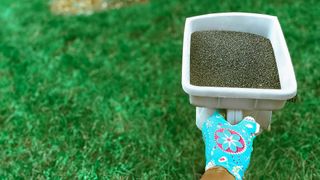Whether you own one of the best gas lawn mowers (opens in new tab) or the best electric lawn mowers (opens in new tab), you won’t get a chance to take them out for a spin if your lawn isn’t in good condition first. We recommend checking out the health of your lawn first before you start fertilizing it. You might find that there are patches of dead grass, moss or even molehills that need flattening before you can begin the necessary lawn fertilization. • Read more: Best riding lawn mowers (opens in new tab) Remove dead grass and reseed or add some new turf to cover any bare areas of lawn. Ensure the lawn is level as possible, as this makes it easier to care for the grass throughout the growing season. Remove any soil from molehills and place it in any borders you may have, as it will provide lots of nutrition for your plants. We’d recommend dealing with any moss growing in the lawn swiftly, as it can spread quickly. Moss looks great under trees or in shady areas, but less so in lawns. Moss needs to be raked up, a task often described as scarifying the lawn. We’d recommend using a spring tine rake. If there are large areas of moss to be removed, you may need to use a moss killer first and replant the lawn before you can undertake lawn fertilization.
Lawn fertilization tips
Check your lawn fertilizer Use a balanced lawn fertilizer at the start of spring, before the grass starts to grow. Choose your lawn fertilization product carefully. Some lawn fertilization products are purely fertilizers, whereas others are a combination of weed and feed, which will kill weeds at the same time as fertilizing your lawn. If you’re using a combined mixture, you will need to be very careful as to the rate you apply it to the lawn. Too little of the mixture will mean that weeds will survive, too much and the lawn may be damaged. Consider how to apply your lawn fertilizer At this time of the year, nitrogen levels start to increase in line with plant growth. Meanwhile, phosphates help the grass store energy and photosynthesize. The third macronutrient is potash, which is essential for increasing disease tolerance and general grass health. Applying a balanced fertilizer at the correct rate of application will help give a strong and dense grass cover, allowing for your lawn to look at its best throughout the year." If you’re opting for a dry lawn fertilizer, it will need to be manually spread out across the lawn. If you have a large lawn, it can be worth using a wheeled lawn feeder to ensure the fertilizer is applied quickly and accurately. Alternatively, you can opt for a liquid fertilizer, which will need to be mixed with water in a watering can and directly applied to the lawn. For larger lawns, a backpack sprayer will help. Wait for the rain The best time to apply lawn fertilization products is when rain is forecast. The rain enables the fertilizer to be washed down the blades of grass and into the plant roots where it will do most good. In fact, leaving fertilizer on the surface of the lawn can damage the leaf blades. If rain doesn’t occur, you should use a hosepipe or watering can (depending on the size of lawn) to water in the fertilizer. Even liquid fertilizers will need the additional watering in after they’ve been applied. Try going organic If you prefer an organic alternative to chemical fertilizers, liquid seaweed is a great option, but it will need applying more often than chemical fertilizers. You will need to apply it approximately once a month between spring and late summer. Seaweed is a natural growth stimulant, increasing the vigor of the grass while discouraging weeds and moss, even in shady areas under trees or tall shrubs where nutrient levels may be low. Read the instructions Judge the amount of lawn fertilizer you need to apply carefully and always read the instructions on the container before applying. The instructions will provide an indication as to how much lawn fertilization is needed per square foot of lawn. You don’t need to be absolutely accurate, just near enough. It is better to be slightly under estimate rather than apply too much, as this will encourage stronger grass roots, which will help the grass to survive. Some adjustments might have to be made depending on the type of grass you have used in your lawn. Lawns planted with lots of rye grass will be happy with larger applications, unlike fescue based lawns. Discover more guides for the garden… Best chainsaws (opens in new tab) Best pool heaters (opens in new tab) Best swim spas (opens in new tab) Best water heaters (opens in new tab) Best patio heaters (opens in new tab)

